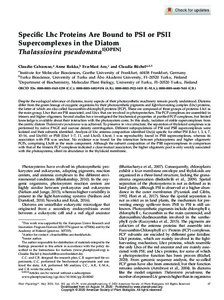Specific Lhc Proteins Are Bound to PSI or PSII Supercomplexes in the Diatom Thalassiosira pseudonana
Claudia Büchel; Eva-Mari Aro; Claudio Calvaruso; Anne Rokka
Specific Lhc Proteins Are Bound to PSI or PSII Supercomplexes in the Diatom Thalassiosira pseudonana
Claudia Büchel
Eva-Mari Aro
Claudio Calvaruso
Anne Rokka
AMER SOC PLANT BIOLOGISTS
Julkaisun pysyvä osoite on:
https://urn.fi/URN:NBN:fi-fe2021042825344
https://urn.fi/URN:NBN:fi-fe2021042825344
Tiivistelmä
Despite the ecological relevance of diatoms, many aspects of their photosynthetic machinery remain poorly understood. Diatoms differ from the green lineage of oxygenic organisms by their photosynthetic pigments and light-harvesting complex (Lhc) proteins, the latter of which are also called fucoxanthin-chlorophyll proteins (FCP). These are composed of three groups of proteins: Lhcf as the main group, Lhcr that are PSI associated, and Lhcx that are involved in photoprotection. The FCP complexes are assembled in trimers and higher oligomers. Several studies have investigated the biochemical properties of purified FCP complexes, but limited knowledge is available about their interaction with the photosystem cores. In this study, isolation of stable supercomplexes from the centric diatom Thalassiosira pseudonana was achieved. To preserve in vivo structure, the separation of thylakoid complexes was performed by native PAGE and sucrose density centrifugation. Different subpopulations of PSI and PSII supercomplexes were isolated and their subunits identified. Analysis of Lhc antenna composition identified Lhc(s) specific for either PSI (Lhcr 1, 3, 4, 7, 10-14, and Lhcf10) or PSII (Lhcf 1-7, 11, and Lhcr2). Lhcx6_1 was reproducibly found in PSII supercomplexes, whereas its association with PSI was unclear. No evidence was found for the interaction between photosystems and higher oligomeric FCPs, comprising Lhcf8 as the main component. Although the subunit composition of the PSII supercomplexes in comparison with that of the trimeric FCP complexes indicated a close mutual association, the higher oligomeric pool is only weakly associated with the photosystems, albeit its abundance in the thylakoid membrane.
Kokoelmat
- Rinnakkaistallenteet [19218]
